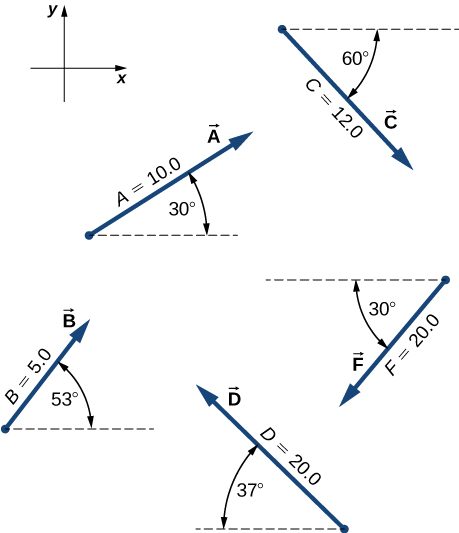| << Chapter < Page | Chapter >> Page > |
| Multiplication by a scalar (vector equation) | |
| Multiplication by a scalar (scalar equation for magnitudes) | |
| Resultant of two vectors | |
| Commutative law | |
| Associative law | |
| Distributive law | |
| The component form of a vector in two dimensions | |
| Scalar components of a vector in two dimensions | |
| Magnitude of a vector in a plane | |
| The direction angle of a vector in a plane | |
| Scalar components of a vector in a plane | |
| Polar coordinates in a plane | |
| The component form of a vector in three dimensions | |
| The scalar z -component of a vector in three dimensions | |
| Magnitude of a vector in three dimensions | |
| Distributive property | |
| Antiparallel vector to | |
| Equal vectors | |
| Components of the resultant of N vectors | |
| General unit vector | |
| Definition of the scalar product | |
| Commutative property of the scalar product | |
| Distributive property of the scalar product | |
| Scalar product in terms of scalar components of vectors | |
| Cosine of the angle between two vectors | |
| Dot products of unit vectors | |
| Magnitude of the vector product (definition) | |
| Anticommutative property of the vector product | |
| Distributive property of the vector product | |
| Cross products of unit vectors | |
| The cross product in terms of scalar
components of vectors |
What is wrong with the following expressions? How can you correct them? (a) , (b) , (c) , (d) , (e) , (f) , (g) , (h) , (i) , and (j) .
a. , b. or , c. , d. , e. , f. , g. left side is a scalar and right side is a vector, h. , i. , j.
If the cross product of two vectors vanishes, what can you say about their directions?
If the dot product of two vectors vanishes, what can you say about their directions?
They are orthogonal.
What is the dot product of a vector with the cross product that this vector has with another vector?
Assuming the + x -axis is horizontal to the right for the vectors in the following figure, find the following scalar products: (a) , (b) , (c) , (d) , (e) , (f) , (g) , and (h) .

Assuming the + x -axis is horizontal to the right for the vectors in the preceding figure, find (a) the component of vector along vector , (b) the component of vector along vector , (c) the component of vector along vector , and (d) the component of vector along vector .
a. 8.66, b. 10.39, c. 0.866, d. 17.32
Find the angle between vectors for (a) and and (b) and .

Notification Switch
Would you like to follow the 'University physics volume 1' conversation and receive update notifications?